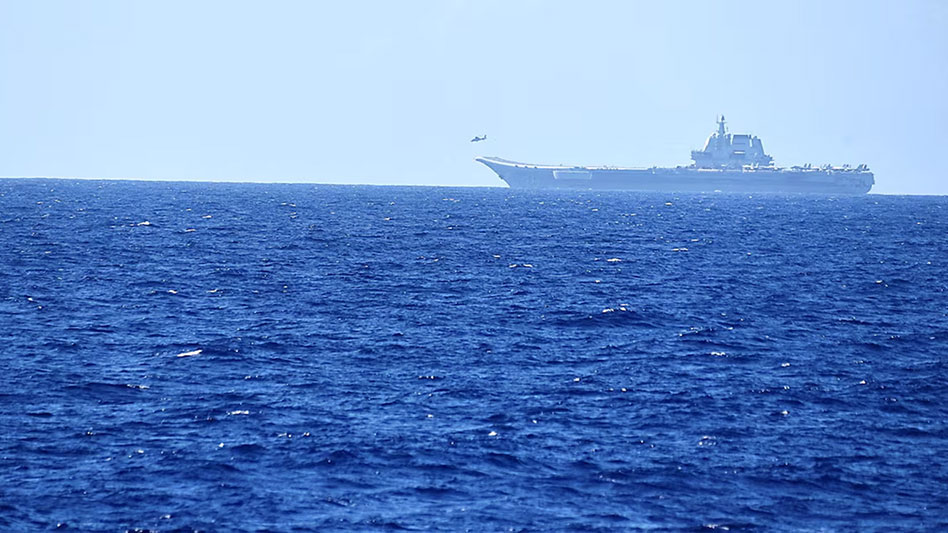Chinese carrier sails close to Philippines on way to Pacific drills

TAIPEI — The Chinese aircraft carrier Shandong passed close to northern Philippines on its way to drills in the Pacific, Taiwan’s Defense minister said on Wednesday, as Taipei reported dozens of warplanes joining the ship for exercises.
The maneuvering of the carrier through waters closer to the Philippines than to Taiwan comes during a period of rising tensions between Beijing and Manila over their South China Sea dispute.
Taiwan, which China claims as its own territory, keeps a close watch on all Chinese movements given the daily military activity around the island.
Taiwan’s Defense ministry said starting around dawn on Wednesday, it had detected 36 Chinese military aircraft, including J-16 fighters and nuclear-capable H-6 bombers, flying to the south and southeast of the island heading to the Western Pacific to carry out drills with the Shandong.
Speaking to reporters in Parliament shortly before his ministry announced details of the latest mission by the Shandong, commissioned by China in 2019, Taiwan Defense Minister Wellington Koo said they had a “full grasp” of the ship’s movements.
“It did not pass through the Bashi Channel,” he said, referring to the waterway that separates Taiwan from the Philippines and is the usual route Chinese warships and warplanes take when they head into the Pacific.
“It went further south, through the Balintang Channel, to the Western Pacific,” Mr. Koo added, a waterway between the Philippines’ Batanes and Babuyan Islands.
China’s Defense ministry did not immediately respond to a request for comment.
The Philippine military said it was concerned with the deployment of the Chinese carrier group.
“We emphasize the importance of maintaining peace and stability in the region and urge all parties to adhere to international laws and norms,” spokesperson Francel Margareth Padilla said.
The Philippines is involved in a bitter standoff with China over the disputed Second Thomas Shoal in the South China Sea.
Late Tuesday, Japan’s Self Defense Forces said they detected the Shandong along with an escort of two missile destroyers and a frigate about 500 km (310 miles) south of its Okinawa islands.
Two Japanese navy ships were observing their movements while Japanese fighter jets scrambled in response to the aircraft launched by the carrier, it said in a statement.
Taiwan earlier reported the Shandong operating near the island, including in December when it passed through the Taiwan Strait just weeks ahead of Taiwanese elections.
Taiwan President Lai Ching-te told the new de facto US ambassador to Taipei, Raymond Greene, on Wednesday that his government would strive to maintain the status quo in the Taiwan Strait “in the face of China’s repeated challenges and attempts to change it.”
Mr. Greene highlighted to Mr. Lai the US commitment to support Taiwan’s ability to defend itself, according to a statement from the American Institute in Taiwan.
The United States is Taiwan’s most important arms supplier, despite the lack of formal diplomatic ties.
Taiwan holds its annual Han Kuang war games starting July 22, and China has stepped up its own activities ahead of that.
Since the start of this month, Taiwan has reported detecting a total of more than 270 Chinese military aircraft operating around the island, as well as two Chinese “joint combat readiness patrols” with warplanes and warships.
One security source, who is familiar with Chinese deployments in the region, told Reuters the better weather of the summer months was when China traditionally carries out drills, but noted the “unusual” uptick in recent movements.
“The security situation around Taiwan is worrying,” the source added, speaking on condition of anonymity as they were not authorized to comment publicly.
China has made no secret of its dislike of Mr. Lai, and carried out two days of war games shortly after he took office in May.
China says he is a “separatist” and has rebuffed his repeated offers of talks. Mr. Lai rejects Beijing’s sovereignty claims, saying only Taiwan’s people can decide their future.
‘HUMANITARIAN GROUNDS’
Meanwhile, China’s coast guard said it had on humanitarian grounds “allowed” the Philippines to evacuate a person who had fallen ill on a rusting warship beached on the Second Thomas Shoal, a claim Manila’s coast guard said was “ridiculous.”
“This statement confirms their illegal deployment of vessels within our EEZ (exclusive economic zone) and highlights their government’s view that the preservation of human life and welfare requires approval,” Philippine Coast Guard (PCG) spokesman Jay Tristan Tarriela said on X.
In a statement, the Chinese Coast Guard said it had monitored the entire rescue operation on Sunday, which a spokesperson said was made at the request of the Philippines.
The Philippine coast guard then reported “numerous obstructing and delaying maneuvers” by China’s coast guard while it carried out the medical evacuation.
A month ago, the PCG accused its Chinese counterpart of blocking a medical evacuation from the warship, calling the actions “barbaric and inhumane”.
China’s foreign ministry said the same day that China will allow the Philippines to deliver supplies and evacuate personnel if Manila notifies Beijing ahead of a mission. The Philippines has soldiers living aboard a rusty, aging warship on Second Thomas Shoal, which Manila grounded in 1999 to reinforce its sea claims.
China’s navy has clashed several times with Philippines forces seeking to resupply the grounded ship.
China claims most of the South China Sea, a key conduit for $3 trillion of annual ship-borne trade, as its own territory. Beijing rejects the 2016 ruling by The Hague-based Permanent Court of Arbitration which said its expansive maritime claims had no legal basis. — Reuters



